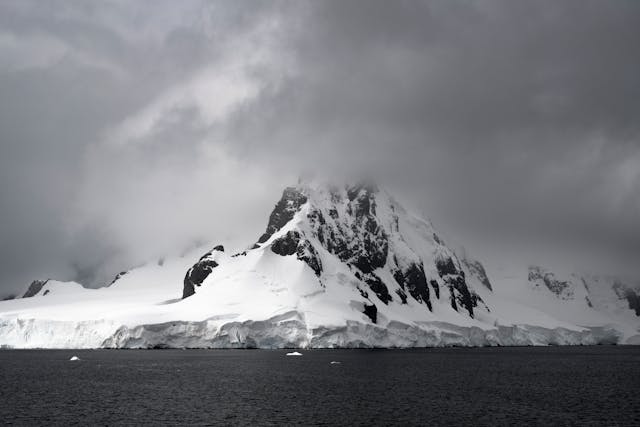
What was Antarctica like before the snow? Before it froze, Antarctica was a tropical forest with large trees and a lot of wildlife.
First, we need to settle the difference between the Antarctic and the Arctic. It can be difficult to remember which is which, at least for me. It gets easier when you learn that “arctic” comes from the Greek “arktikos”, which means “of the north”. It comes from “arktos”, which means bear and was used to refer to the Ursa Major constellation, also known as the bear constellation, that is seen in the north. “Antarctic” comes from the Greek “antartyk”, which means opposite to the north. That makes it much easier to remember.
The main difference between the Arctic and the Antarctic is that the Arctic is an area of frozen ocean and Antarctica is a continent with ice on top of it. This is the biggest difference and the reason for today’s topic. It is also why the melting of the Antarctic is more worrying than the melting of the Arctic. The Arctic ice is already in the sea and won’t raise sea levels. If the Antarctic melts and runs into the ocean, it will raise sea levels significantly.
Antarctica is colder than the Arctic and is one of the coldest and driest places on Earth. It is so cold that it is actually the world’s largest desert, bigger than the Sahara Desert. There is almost no precipitation throughout the year. It snows a lot on the edge of the continent, but there is almost no snow in the center. It hasn’t snowed in some places for millions of years and a lot of the snow that falls is blown from other places. Antarctica is 14,200,000 km2, which makes it the fifth largest continent. It is bigger than Europe. It is covered by the Antarctic ice sheet which has an average thickness of 1.9 km. There are several animals that make it their home, such as penguins, and seals. Polar bears live in the Arctic, not the Antarctic. There is also not a lot of vegetation because it is too cold, windy, and dry. The vegetation that does exist can extract moisture from the air. The Arctic has a lot more vegetation. However, the Antarctic wasn’t always like this. It used to be a tropical forest.
Fossils have been found on Antarctica which show that it used to be a tropical rainforest. Fossils of the leaves and of plants have been found. There were lots of different animals as well. Researchers took a core sample of soil from the sediment of the seabed on the edge of Antarctica, and it was full of pollen, the fossils of roots, spores, and leftover bits of flowering plants. The soil in the sample is 90 million years old, and to have sustained that much life, the temperature would have needed to be warmer than central Europe today and there wouldn’t have been any ice on Antarctica.
So, what changed? Two things changed. The first thing that changed was the position of the continent. Before Antarctica was in the position it is in now, it was part of the supercontinent, Pangea. Antarctica was in the northern hemisphere from roughly 500 to 200 million years ago. About 160 million years ago, Africa, India, Antartcia, South American, and Australia made up Gondwana, which was the southern half of Pangea. Slowly, Africa and India separated from Antarctica. Antarctica stayed attached to South America and Australia until at least 30 million years ago, by which time it was surrounded by sea and had moved to its current position at the south of the planet. Being at the pole meant that it was naturally much colder, but even then, there is still evidence that there were plants and animals living on Antarctica. It took a big change in the climate to get the snow that we have today.
The second reason for the ice forming was a reverse greenhouse effect. By 100 million years ago, large quantities of carbon dioxide had built up in the atmosphere and the global temperature was higher than it is today. Then, gradually, the amount of carbon dioxide began to go down, which brought the temperature down. The carbon dioxide began to fall because there were more plants to take it up and the expanding seas could absorb more. Then, as the temperature began to fall, Antarctica began to freeze. This new ice came from the sea and as it froze, sea levels dropped, bringing more land to the surface where more trees could grow, and more carbon dioxide was pulled out of the atmosphere. It was runaway cooling. As the seawater became colder it started to absorb more carbon dioxide because colder water can hold more CO2 than warm water can. The dropping temperatures fueled more temperature falls, in the exact opposite direction to what we have today. And, within a few million years, Antarctica was the snow covered place that it is today. And this is what I learned today.
Photo by Hugo Sykes: https://www.pexels.com/photo/view-of-an-ice-sheet-and-snowcapped-mountain-under-dark-clouds-in-antarctica-20433668/
Sources
https://www.etymonline.com/word/antarctic
https://www.etymonline.com/word/arctic
https://www.space.com/ursa-major-constellation-great-bear
https://en.wikipedia.org/wiki/Antarctica
https://www.imperial.ac.uk/news/196516/traces-ancient-rainforest-antarctica-point-warmer
